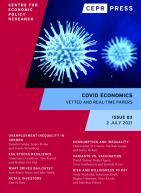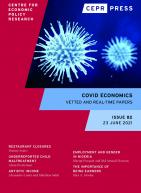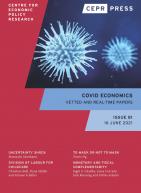
Is a lockdown an effective means to limit the spread of the COVID-19 pandemic? We study the case of Sweden—one of the few countries without a lockdown—and use synthetic control techniques to develop a counterfactual lockdown scenario. First, we use a “donor pool†of European countries to construct a doppelganger that behaves just like Sweden in terms of infections before the lockdown. Second, we find that infection dynamics in the doppelganger since the lockdown do not systematically differ from the actual dynamics in Sweden. Third, we study Google mobility data and find that Swedes adjusted their activities in similar ways as in the doppelganger, although to a somewhat lesser extent.
Citation
Dietrich, A, G Müller and B Born (2020), ‘Do Lockdowns Work? A Counterfactual for Sweden‘, COVID Economics 16, CEPR Press, Paris & London. https://cepr.org/publications/covid-economics-issue-16#392514_392892_391029
On average, women comprise a smaller share of deaths from Covid-19. However, variation in the share of Covid-19 deaths for women across countries and US States suggests that biological factors cannot fully account for this gender difference. I hypothesize that women’s participation in the workforce is related to women’s share of Covid-19 deaths. I show that the percent of the full-time workforce comprised by women is positively related to the percent of female Covid-19 deaths across countries. I also show that the percent of the full-time workforce comprised by women is positively related to the incidence of various diseases associated with a more severe impact of Covid-19 and the percent of medical doctors and nurses who are women. My results suggest that in countries where women participate more fully in the workforce, women may be more susceptible to Covid-19 due to increased exposure to the virus and a higher risk of developing comorbidities. Future research should be careful to consider social factors when examining gender differences in health outcomes
Citation
Adams, R (2020), ‘Gender Equality in Work and Covid-19 Deaths‘, COVID Economics 16, CEPR Press, Paris & London. https://cepr.org/publications/covid-economics-issue-16#392514_392892_390438
We provide real-time evidence on the impact of Covid-19 restrictions policies on conflicts globally. We combine daily information on conflict events and government policy responses to limit the spread of coronavirus to study how conflict levels vary following shutdown and lockdown policies. We use the staggered implementation of restriction policies across countries to identify their effect on conflict incidence and intensity. Our results show that imposing a nation-wide shutdown reduces the likelihood of daily conflict by around 9 percentage points. The reduction is driven by a drop in the incidence of battles, protests and violence against civilians. Across actors the decline is significant for conflicts involving political militias, protesters and civilians. We also observe a significant cross-country heterogeneity in the effect of restriction policies on conflict: no conflict reduction is observed in low income countries and in societies more fractionalized along ethnic or religious lines. We discuss the potential channels that can explain this heterogeneity.
Citation
Ticku, R, M Couttenier, N Monnet and N Berman (2020), ‘Shutdown policies and conflict worldwide‘, COVID Economics 16, CEPR Press, Paris & London. https://cepr.org/publications/covid-economics-issue-16#392514_392892_390439
Governments are starting to ease restrictions to economic activity. The risks of easing these measures too soon, or in misguided ways, are obvious, not only for public health but also for the economy. A world with no lockdown and a pandemic spreading rapidly through the population does not make for a healthy economy; nor, in all likelihood, does a world in which containment measures have to be repeatedly re-instated after being eased prematurely or in sub-optimal ways. We discuss some key economic issues that the UK government needs to face when thinking about how best to get people back into work: we assemble some basic empirical evidence, identify some challenges that policy-makers will need to confront, and discuss some policy considerations
Citation
Levell, P, R Joyce, C Farquharson, R Griffith and M Costa Dias (2020), ‘Getting people back into work‘, COVID Economics 16, CEPR Press, Paris & London. https://cepr.org/publications/covid-economics-issue-16#392514_392892_390440
Assuming that there is no other solution than herd immunity in front of the current pandemic, on which categories of citizens should we build this herd immunity? Given the fact that young people face a mortality rate which is at least a thousand times smaller than people aged 70 years and more, there is a simple rational to build it on these younger generations. The transfer of some mortality risk to younger people raises difficult ethical issues. However, none of the familiar moral or operational guidelines (equality of rights, VSL, QALY, ...) that have been used in the Western world over the last century weights the value of young lives 1000 times or more than the lives of the elders. This suggests that Society could offer covid protection to the elders by confining them as long as this herd immunity has not been attained by the younger generations. This would be a potent demonstration of intergenerational solidarity towards the most vulnerable people in our community. The welfare gain of this age-specific deconfinement strategy is huge, as it can reduce the global death toll by more than 80%.
Citation
Gollier, C (2020), ‘If the objective is herd immunity, on whom should it be built?‘, COVID Economics 16, CEPR Press, Paris & London. https://cepr.org/publications/covid-economics-issue-16#392514_392892_390441
This paper develops a Nash-equilibrium extension of the classic SIR model of infectious-disease epidemiology ("Nash SIR"), endogenizing people's decisions whether to engage in economic activity during a viral epidemic and allowing for complementarity in social-economic activity. An equilibrium epidemic is one in which Nash equilibrium behavior during the epidemic generates the epidemic. There may be multiple equilibrium epidemics, in which case the epidemic trajectory can be shaped through the coordination of expectations, in addition to other sorts of interventions such as stay-at-home orders and accelerated vaccine development. An algorithm is provided to compute all equilibrium epidemics.
Citation
McAdams, D (2020), ‘Nash SIR: An Economic-Epidemiological Model of Strategic Behavior During a Viral Epidemic‘, COVID Economics 16, CEPR Press, Paris & London. https://cepr.org/publications/covid-economics-issue-16#392514_392892_390442
In this paper we construct country specific indices of mobility and trust. We use Google Covid 19 Community Mobility Reports for the former, and World Values Survey and the European Values Study for the latter. We find that the trust index has some power in explaining mobility attitudes of nations, and trust increases mobility around workplaces, groceries/pharmacies, parks, and transit stations. We then present a model where people decide whether to stay at home or go out and if they go out how much effort to spend to protect themselves from the disease which has positive externalities on others. We assume that the effort cost of protection depends on the norm in the community and show that more people can go out when either the norm increases or people put more weight on it. Interpreting the weight on the norm as a measure of trust, our theory sheds light on the empirical findings.
Citation
Ozdenoren, E and T Doganoglu (2020), ‘Should I stay or should I go (out): The role of trust and norms in disease prevention during pandemics‘, COVID Economics 16, CEPR Press, Paris & London. https://cepr.org/publications/covid-economics-issue-16#392514_392892_390443
This note outlines a simple method for estimating the spread of the COVID 19 virus in the absence of data on test results for a large, random sample of the population. It applies the method to the UK, and other countries, and finds that to match data on daily new cases of the virus, the estimated model favours high values for the number of people infected but asymptomatic. That result is very sensitive to whether the transmission rate of the virus is different for symptomatic and asymptomatic cases, something about which there is significant uncertainty. This illustrates how difficult it is to estimate the spread of the virus until very large samples of the population can be tested. Nonetheless, there is evidence that the infection may have spread far enough to mean that the trajectory of falling new cases could be maintained with some easing of restrictions.
Citation
Miles, D and O Dimdore-Miles (2020), ‘Assessing the Spread of the Novel Coronavirus In The Absence of Mass Testing‘, COVID Economics 16, CEPR Press, Paris & London. https://cepr.org/publications/covid-economics-issue-16#392514_392892_390444


Covid Economics - Issue 82
- Restaurant Closures during the Pandemic: A Descriptive Analysis
- Underreporting Child Maltreatment during the Pandemic: Evidence from Colorado
- Covid-19 impact on Artistic Income
- COVID-19, Employment, and Gender: Evidence from Nigeria
- The Importance of Being Earners: Modelling the Implications of Changes to Welfare Contributions on Macroeconomic Recovery
